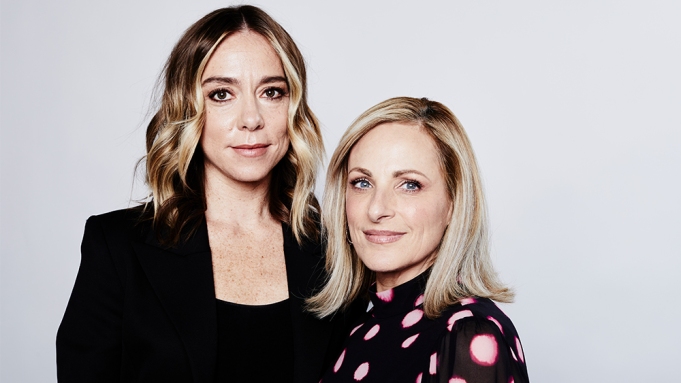By Matthew Carey
December 1, 2021 10:00am
Deadline
The 2014 French drama La Famille Bélier centered on a young woman growing up in a family with deaf parents, but for the most part the filmmakers cast hearing actors to play the deaf roles. Writer-director Siân Heder was determined not to take that same approach when she set about making CODA, her award-winning adaptation of the French film, and thus began her collaboration with actress Marlee Matlin. Heder cast the Oscar winner as mom Jackie Rossi, along with fellow deaf actors Troy Kotsur as husband Frank, and Daniel Durant as son Leo, while hearing actress Emilia Jones plays Ruby Rossi, the titular ‘CODA’—an acronym for Child of Deaf Adults.
In conversation with Matt Carey, Heder and Matlin discuss how they set about telling an authentic and moving story in a film that sold in a record-breaking deal out of Sundance.
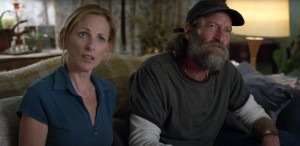 DEADLINE: Siân, describe your thought process as you went about casting the film.
DEADLINE: Siân, describe your thought process as you went about casting the film.
Marlee Matlin and Troy Kotsur in CODA
Apple TV+/Courtesy Everett Collection
SIÂN HEDER: It just seemed to be such a shame that in a moment where you could represent a deaf family on screen, that you would not use deaf talent in those roles to authentically represent that culture and that family. So, that was the first thing I felt even going into this story that if I was going to try to tell it, I wanted to make sure it was as authentic a representation of this family and this culture as I could have.
And it was very important to me to cast deaf actors and Marlee was always in my mind, because I knew her work. She’s obviously an Oscar-winning actress and incredibly talented, and I think hasn’t had the opportunities that I feel she should have had through her career based on her incredible talent. And so, as I was writing, I had her in the back of my mind and then she was the first person I met and the first person I brought onto the project.
MARLEE MATLIN: (speaking via ASL interpreter Jack Jason): When I met Siân and we had an in-depth discussion about the script, I mentioned to her, “It’s just been too long [casting actors] to play deaf people who aren’t deaf,” knowing that there are great deaf actors out there. For so long we’ve been overlooked. And now it was time to say stop and cast authentic deaf actors in roles. And when I met with her, I knew I was in the right place because she was on the same page as I was. Her love for our community, her love for our culture and the language—she knew what it was all about… She already began learning sign language, began asking questions, she did her homework, she rolled up her sleeves, which is different than the experiences I’ve had with directors in the past.
 Media: CODA. Apple Original Films
Media: CODA. Apple Original Films
HEDER: It felt amazing to have an ally and to have a collaborator and someone who was willing to fight for the same things that I was because there was definitely resistance. It was originally a studio project and there was resistance to casting deaf actors in all of these roles because they’re very focused on star names and getting a movie star in the movie… Up until meeting Marlee, it had just been me fighting those fights. It felt like I had my first collaborator and my first partner in the fight to really take a stand for the way that we wanted to make the film and not be willing to compromise on those things that really felt so important to both of us.
DEADLINE: What was it like working together as director and actor?
HEDER: The way Marlee talked about the script and the depth with which she had read this role and was thinking about the dynamics within this family—she has four CODA children of her own [in real life]—and was bringing all of that experience, not just through her lived experience as herself, but also as a mother and what that is to be raising CODA children.
MATLIN: A lot of times directors that I work with would just come in and say, “Well, she’s signing, she must be doing a good job. We can move on.” And I never really had an opportunity to work one-on-one, as I did with Siân. It’s a very rare experience. And it’s a very important relationship for an actor with a director.
HEDER: Right from the first couple days I remember, Marlee, I was really pushing you and we were doing many takes… And I think it was exciting for Marlee, as it was exciting for me, to really work and dig out this character and work on performances and explore different things.
MATLIN: As it should be, as it should be. She kicked my ass.
HEDER: I did. I kicked her ass.
MATLIN: In a beautiful way. And it should be, working together. She’s an actor’s director.
HEDER: Also, I have to say it was very helpful to me that we had two ASL masters on the project, Alexandria Wailes and Anne Tomasetti. Those roles were really key. Alexandria worked on the translation of the script with me—50 percent of the movie was in ASL. We made sign choices based on what I felt like were revealing the meaning that I wanted as a writer. And then my actors got involved and, of course, had a lot of input about sign choice: “This is how I feel Jackie would say this…” There are regionalisms to sign language. Just like there is a Boston accent, there are signs that deaf people use in Boston.
I was conversational in sign. So, it wasn’t like I was watching something that I was clueless about. At the same time, I would never have caught the kind of things that Anne had her eyes on… Anne was there to go, “Troy keeps throwing in secret ‘fucks’ and I don’t know that you want that many ‘fucks’ in your movie.” And there were a lot of secret ‘fucks’ that I wouldn’t have caught had Anne not been there. Having Anne on set to be my deaf eyes behind the camera, I could focus on working with my actors really on the subtleties of performance and exploring different options for a very complex, emotional story and the dynamics of this family.
 DEADLINE: So Marlee, I have to check with you—Siân says she’s conversational in sign. Is that true?
DEADLINE: So Marlee, I have to check with you—Siân says she’s conversational in sign. Is that true?
Media: Apple TV+
MATLIN: Talk with me privately, I’ll tell you the truth [laughs]. No, honestly, she was awesome. She knew when she wasn’t signing properly—she was aware, she was clued in enough to her sign language. It was funny to see her say something to herself [in sign], like, “That’s not the way to sign it.” I could see her talking to herself and then I would watch her and she’s sitting there. “I don’t know if you want me to help you, Siân, or if you’re just happy talking to yourself, or what was it that you are doing there?” I think she wanted my help. It was a cry for help. So, then I would jump in and give her a sign, but she was extremely passionate.
HEDER: And to be clear, when I say I’m ‘conversational,’ four-year-olds are conversational, too. It doesn’t mean that they’re having deep conversations, but they are conversations. I mean, being mocked by my actors for my signing was just a part of the process. The amount of times Marlee would laugh in my face and be like, “That is definitely not the sign that you want to use right now.”
MATLIN: But you laughed with us.
HEDER: Oh, completely. And that’s how you learn.
MATLIN: Being on the set, as I’ve said, I was totally in my element. By that I mean that I was within my culture, my community, every day, from the first day I was there. I was not accustomed to having almost everywhere I looked an interpreter or a cast member who could sign or a crew member who could sign. Everything was so available and accessible, I just wasn’t accustomed to that. I’m accustomed to saying [on a set], “Hi, I’m Marlee. This is my interpreter. This is how you’re going to have to talk to me.” And it’s sort of a game of telephone there… Like it was on The West Wing or The L Word, the pace of conversation was so quick, and it was tough for me as a deaf actor. But in this case, it was our pace, our language, and it just was about the most liberating experience you could expect. And it was so relaxing, and we could really focus on the work as actors—work on the work.
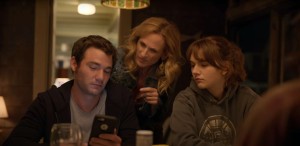 DEADLINE: Marlee, I’m curious, to what degree did the script evolve from the original version, based on your input?
DEADLINE: Marlee, I’m curious, to what degree did the script evolve from the original version, based on your input?
Media: Apple TV+/Courtesy Everett Collection
MATLIN: Clearly, you have to deliver what’s on the page. So, I really didn’t go beyond the lines without the permission of Siân. But I think in the process of rehearsal and working with the deaf actors together at the table, we were able to delve deeper beyond the simple translations or whether we chose to extrapolate with a different sign choice or whatever made sense for that character.
But we made sure that whatever it was, it was what Siân wanted and in the spirit of what she wanted, the meat of what she wanted in the story. So, there were some opportunities for us to improvise—mostly Troy, who did it all. I mean, he really went above and beyond with his brilliant, but absurd sense of humor and his sign language that made the entire crew and the entire cast just drop to the floor and roll around laughing.
HEDER: Yes, Marlee is right, the actors honored the lines that I wrote. For me, the interesting part of it was that ASL and English are completely different languages. And they’re not just different in sentence structure and grammar—which they are—they’re different conceptually in how an idea is expressed, how an emotion is expressed. And so, for me, it was a huge education in translating written English into this purely visual language and the way concepts and ideas and jokes are expressed is so different that it was this incredible process of discovery.
That was really the gift that Marlee was bringing, Troy was bringing, Daniel was bringing, was going, “OK, there’s this line, which has a meaning in English, but what’s underneath the line? Like, what does this line really mean? What does this character want? What are they trying to express? What is the subtext?” And we would have those conversations about almost every line. And then that really influenced the sign choices of how this is being expressed. Is it literal? Is the character saying exactly what they mean? Or are these kind of the surface words and there’s something else underneath it, because that would affect sign choice in what was expressed or what wasn’t.
There were a lot of times where I found the limits of English and there were moments that I didn’t even subtitle in the film because what was being expressed in ASL was beautiful and not able to be translated back into English words… It was also fun to have a hearing audience probably be catching things that were in the ASL that were not in the subtitles. The sex talk—when Troy does this entire condom demonstration, which I was never going to subtitle because how the hell would I ever subtitle for that? And if I subtitled it, the MPA definitely would’ve given this movie an R.
MATLIN: X!
HEDER: NC-17.
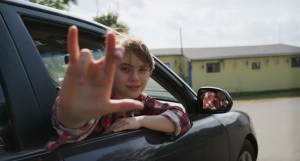 DEADLINE: One thing that hearing audiences probably wouldn’t think about, Marlee, is that you as a deaf actor could certainly flub a line on set. I mean, you’re memorizing dialogue. But your director doesn’t know you’ve flubbed a line, so that’s where the ASL master comes in.
DEADLINE: One thing that hearing audiences probably wouldn’t think about, Marlee, is that you as a deaf actor could certainly flub a line on set. I mean, you’re memorizing dialogue. But your director doesn’t know you’ve flubbed a line, so that’s where the ASL master comes in.
Media: Apple/Vendome
MATLIN: These are secrets one does not reveal. I can probably count 30 different instances where I’ve gotten away with sign language flubs, but no—I mean, I’m a perfectionist, I have to say. And particularly with Siân, with her hawk eyes and the hawk eyes of [ASL masters] Anne and Alexandria, that if I made a mistake, we would actually go back and shoot again.
DEADLINE: Marlee, I’m wondering what ways Siân was able to support you and help you put in your best performance on this film?
MATLIN: She didn’t define me by my deafness. As I’ve said so often, she’s woman-to-woman as a director, she’s mother-to-mother as a director and she listens and she uses what she listens to and directs. She has a very strong sense of empathy in a way that is so positive. There’s no bullshit there. She has a great sense of humor, and she knows her stuff. She has her head on her shoulders. The one thing I worried about with Siân—nothing else in all honesty, the one thing I worried about—I don’t think she ate enough.
HEDER: I didn’t. Marlee followed me around on set with snacks. She was like, “Eat this, eat that, put some nuts in your face. Why aren’t you eating?” Oh, that sounded dirty. I didn’t mean to say that.
MATLIN: She’s so beautiful, so thin, she needed fuel. She needed fuel to do her job. She was like, “Yeah, OK, whatever Marlee.”
HEDER: Marlee was such a mom on the set. Jackie is the matriarch of the family [in the movie]. Marlee was the matriarch of our set and her care for everybody—she is a caretaker, so it’s not just her fellow actors and me, it’s the crew, it’s saying hello to everybody on the set in the morning, saying thank you to every single person on the set as she leaves. She is the most gracious, present person.
MATLIN: Did you like the cookie sandwiches that I got? The cookie sandwich truck. How about that? I doubt you had one though, Siân. You probably didn’t eat one.
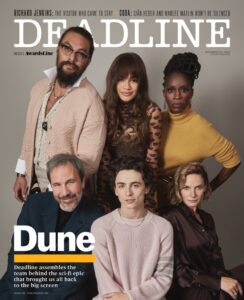 HEDER: I was too busy, I was too busy. But it’s true, I think it’s hard when you are working with assholes, and we were so lucky on this set to have zero assholes.
HEDER: I was too busy, I was too busy. But it’s true, I think it’s hard when you are working with assholes, and we were so lucky on this set to have zero assholes.
MATLIN: Yay for that!
HEDER: It’s such a gift when you work with people that are genuinely giving, who are there to support their fellow actors, who are present for their fellow actors, present for the movie and the story you’re telling, who work so hard without complaint.
Media: Siân Heder and Marlee Matlin are featured in Deadline’s Oscar Preview issue with Dune on the cover.

